 |
| ENTRANCE AND THE MAIN STREET
The ancient city is divided by the main street which is about 1 km long. There are columnar governmental galleries on both sides. There are also monumental entrances at the beginning and at the end of the main street. The area is outside of the Byzantine city walls, because the gates, most of the main street, and most of the side streets were built in the Roman Period.
|
|
 |
|
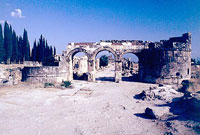 |
|
The South Byzantine Gate on the south edge of the city is dated at 5 A.D. The well-preserved North Gate has two round towers and inscriptions in Greek and Latin honoring Emperor Domitian. That's why the gate is also called the Domitian Gate. The gate was built in 82-83 A.D. by Julius Sextus Frontinus. The gate is also called Frontinus Gate because of its architect. The gate is situated where the city walls cross the street. |
|
| CITY WALLS
The city walls were built in accordance with a law issued in 396 AD. similar to other cities of the Roman Empire with walls on the north, south and east sides of the city. 24 square towers are placed along the city walls. There are 4 entrances, two with monumental gates and two more small gates. |
|
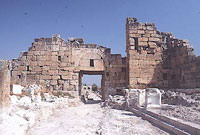 |
|
| The monumental gates are situated on the main street. Unfortunately, most of the city walls were destroyed. |
|
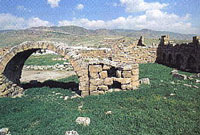 |
|
GREAT BATH COMPLEX
There are marks that indicate that the bath's inner walls used to be covered with marble. Some of the walls and vaults of the bath and are still standing. The plan is typical of other Roman Baths. There is a large court at the entrance, large halls on both sides, a rectangular enclosed area, and the actual bathing area. |
|
| Two large halls within the Palaestra (sports arena) were reserved for the Emperor's use and for celebrations. The ruins of the Great Bath Complex date to 2 A.D. The restored part of the building is used as a museum today. |
|
| APOLLON TEMPLE
The temple is situated in a religious cave, which is called Plutonium. The oldest religious center of the local people is the place where Apollon met the mother goddess, Kybele. The poisonous gas of that cave did not affect the priest of Kybele.
|
|
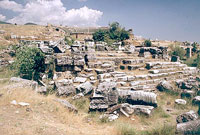 |
|
| The temple's foundation is dated in the late Hellenistic Period, but the rest of the temple is dated in the 3rd century A.D. There are large steps at the Temple's entrance. |
|
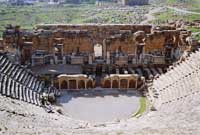 |
|
THEATER
It's a great, well-preserved Greek style building, which is situated on a hillside. It is 91 meters high. The theater's construction was started in 62 A.D. after the earthquake of 60 AD in the Flavius era. However, it was not completed in the Hadrian era. It was finally completed in the Severus Era in 206 A.D. The cavea is separated into
7 parts by 8 steps, and there are 50 seats. |
|
| The Diozoma (a kind of passage) is in the middle of the cavea with a vomitorium with 2 vaults.
There are 10 columns in front of the kingdom box and
orchestra, which are 3.66 meters high. The front door of the scene has 5 gates and 6 niches. The niches are behind the columns which are decorated with oyster shells and among the columns adorned with statues. Many statues were found during the excavations. There are marble embossments on the wall which is behind the scene. |
|
 |
|
 |
|
ST. PHILIPS'S MARTYRIUM
It's an octagonal building which is 20 m x 20 m. The Martyrium was built at the end of the 4th century and early 5th century in honor of St. Philip who was murdered here. |
|
| CHURCHES
There is a cathedral dated in the 6th or 7th century A.D., a columnar church, and two more churches. Moreover, the main hall of the Great Bath was transformed into a church. There are also small prayer rooms on the north part of the city. |
|
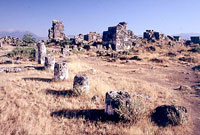 |
|
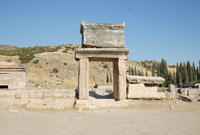 |
|
NECROPOLIS
Except for the travertine area on the west, the other sides of the city are necropolis areas. They may especially be seen on the roads which go to Laodicea - Colossae on the south and to Tripolis - Sardis on the north. Limestone and marble were used to build the cemeteries. |
|
| The north Necropolis spans the time from the Late Hellenistic era to the early Christian era with sarcophagi, house-type cemeteries, tumulus-type cemeteries, and monuments. |
|
| THE SACRED POOL
Which coincidentally contains many ancient column pieces is located in the Pamukkale Motel and is not to be missed. This pool may well easily be the remains of the original pool of the antiquity near the Apollo Temple. As John Freely says, "There cannot be another hotel in the world that has a swimming pool like this". |
|
|
 |
|
|
|